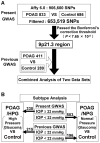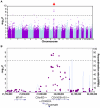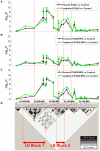Common variants in CDKN2B-AS1 associated with optic-nerve vulnerability of glaucoma identified by genome-wide association studies in Japanese
- PMID: 22428042
- PMCID: PMC3299784
- DOI: 10.1371/journal.pone.0033389
Common variants in CDKN2B-AS1 associated with optic-nerve vulnerability of glaucoma identified by genome-wide association studies in Japanese
Abstract
Background: To date, only a small portion of the genetic variation for primary open-angle glaucoma (POAG), the major type of glaucoma, has been elucidated.
Methods and principal findings: We examined our two data sets of the genome-wide association studies (GWAS) derived from a total of 2,219 Japanese subjects. First, we performed a GWAS by analyzing 653,519 autosomal common single-nucleotide polymorphisms (SNPs) in 833 POAG patients and 686 controls. As a result, five variants that passed the Bonferroni correction were identified in CDKN2B-AS1 on chromosome 9p21.3, which was already reported to be a significant locus in the Caucasian population. Moreover, we combined the data set with our previous GWAS data set derived from 411 POAG patients and 289 controls by the Mantel-Haenszel test, and all of the combined variants showed stronger association with POAG (P<5.8 × 10(-10)). We then subdivided the case groups into two subtypes based on the value of intraocular pressure (IOP)--POAG with high IOP (high pressure glaucoma, HPG) and that with normal IOP (normal pressure glaucoma, NPG)--and performed the GWAS using the two data sets, as the prevalence of NPG in Japanese is much higher than in Caucasians. The results suggested that the variants from the same CDKN2B-AS1 locus were likely to be significant for NPG patients.
Conclusions and significance: In this study, we successfully identified POAG-associated variants in the CDKN2B-AS1 locus using a Japanese population, i.e., variants originally reported as being associated with the Caucasian population. Although we cannot rule out that the significance could be due to the differences in sample size between HPG and NPG, the variants could be associated specifically with the vulnerability of the optic nerve to IOP, which is useful for investigating the etiology of glaucoma.
Conflict of interest statement
Figures



Similar articles
-
Glaucoma risk alleles at CDKN2B-AS1 are associated with lower intraocular pressure, normal-tension glaucoma, and advanced glaucoma.Ophthalmology. 2012 Aug;119(8):1539-45. doi: 10.1016/j.ophtha.2012.02.004. Epub 2012 Apr 21. Ophthalmology. 2012. PMID: 22521085
-
Genetic association between CDKN2B/CDKN2B-AS1 gene polymorphisms with primary glaucoma in a North Indian cohort: an original study and an updated meta-analysis.BMC Med Genomics. 2021 Jan 4;14(1):1. doi: 10.1186/s12920-020-00855-1. BMC Med Genomics. 2021. PMID: 33397358 Free PMC article.
-
CDKN2B-AS1 genotype-glaucoma feature correlations in primary open-angle glaucoma patients from the United States.Am J Ophthalmol. 2013 Feb;155(2):342-353.e5. doi: 10.1016/j.ajo.2012.07.023. Epub 2012 Oct 27. Am J Ophthalmol. 2013. PMID: 23111177 Free PMC article.
-
Chromosome 9p21 primary open-angle glaucoma susceptibility locus: a review.Clin Exp Ophthalmol. 2014 Jan-Feb;42(1):25-32. doi: 10.1111/ceo.12234. Epub 2013 Oct 30. Clin Exp Ophthalmol. 2014. PMID: 24112133 Review.
-
Genetics of primary open-angle glaucoma and its endophenotypes.Prog Brain Res. 2020;256(1):31-47. doi: 10.1016/bs.pbr.2020.06.001. Epub 2020 Jul 1. Prog Brain Res. 2020. PMID: 32958214 Review.
Cited by
-
Extracting Primary Open-Angle Glaucoma from Electronic Medical Records for Genetic Association Studies.PLoS One. 2015 Jun 10;10(6):e0127817. doi: 10.1371/journal.pone.0127817. eCollection 2015. PLoS One. 2015. PMID: 26061293 Free PMC article.
-
Association of Glaucoma Risk Genes with Retinal Nerve Fiber Layer in a Multi-ethnic Asian Population: The Singapore Epidemiology of Eye Diseases Study.Invest Ophthalmol Vis Sci. 2020 Aug 3;61(10):37. doi: 10.1167/iovs.61.10.37. Invest Ophthalmol Vis Sci. 2020. PMID: 32821913 Free PMC article.
-
Primary Open-Angle Glaucoma Genetics in African Americans.Curr Genet Med Rep. 2017 Dec;5(4):167-174. doi: 10.1007/s40142-017-0131-8. Epub 2017 Oct 11. Curr Genet Med Rep. 2017. PMID: 29276656 Free PMC article.
-
Genome-wide association and admixture analysis of glaucoma in the Women's Health Initiative.Hum Mol Genet. 2014 Dec 15;23(24):6634-43. doi: 10.1093/hmg/ddu364. Epub 2014 Jul 15. Hum Mol Genet. 2014. PMID: 25027321 Free PMC article.
-
Gene expression profile in human trabecular meshwork from patients with primary open-angle glaucoma.Invest Ophthalmol Vis Sci. 2013 Sep 27;54(9):6382-9. doi: 10.1167/iovs.13-12128. Invest Ophthalmol Vis Sci. 2013. PMID: 24003086 Free PMC article.
References
-
- European Glaucoma Society. 2008. Terminology and guidelines for glaucoma, 3rd edition (Editrice Dogma, Savona, Italy)
-
- Iwase A, Suzuki Y, Araie M, Yamamoto T, Abe H, et al. The prevalence of primary open-angle glaucoma in Japanese: the Tajimi Study. Ophthalmology. 2004;111:1641–1648. - PubMed
-
- Klein BE, Klein R, Sponsel WE, Franke T, Cantor LB, et al. Prevalence of glaucoma. The Beaver Dam Eye Study. Ophthalmology. 1992;99:1499–1504. - PubMed
MeSH terms
Substances
LinkOut - more resources
Full Text Sources
Medical
Research Materials

